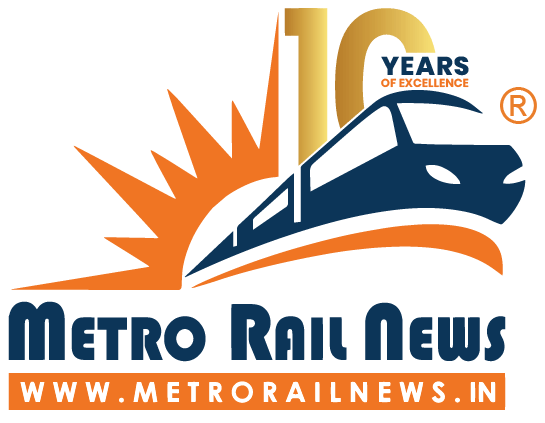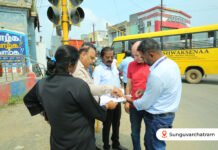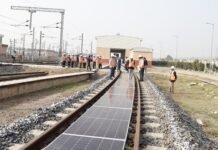Exclusive Interview with Shri Piyush Goyal, Union Minister of Railways & Union Minister of Commerce & Industry in which he talks about public-private partnerships (PPPs), Dedicated freight corridors, Bullet Train Project, privatisation of the Railways and Railway Infrastructure, here is the edited excerpt of the interview.
1. The Railways has been allocated Rs 1,60,76 crore, which is 20% higher than the previous year. Do you think the money is sufficient and how do you plan to spend it?
We have got exactly what we asked for, Railway has improved its performance over the years quite significantly and we have been meeting our capital expenditure target to a large extent, particularly last year. I am grateful to the honorable finance minister for providing adequate funds that we require for our expansion and modernisation plans.
2. Recently, there was a controversy over a coach factory in Rai Bareli, where the Opposition said the Railway is planning to privatise it.
There was no controversy, it’s just a lack of understanding of some people. Either they don’t have a good understanding or they pretend not to understand.
3. Do we see trains being run by private players in future?
We will cross the bridge when we come to it. Nothing has been finalised and we are open to ideas.
4. What is going to be your focus in the second term? Last time you had focused on reducing the number of accidents and managed to bring it down to lowest ever in the history.
For me, we have a holistic vision to make this the world’s best railway. It includes better passenger amenities. It includes better infrastructure, more safety, more capacity to serve our passengers and obviously it also includes freight as an important element. So it’s not restricted to one or the other element only.
5. What is the update on ambitious bullet train project? Do you think it will be completed before the 2022 deadline?
2022 was never a deadline, we will try to do a small portion by that time. The deadline as per the Japanese is December 2023. We have requested them if some portion of it can be fast-tracked.
6. Do you think the hike in fuel charge will have an impact on Indian Railway?
I don’t see any significant impact; we are moving so fast on electrification that I am not worried too much about it
7. The finance minister talked about an investment of Rs 50 lakh crore between 2018 and 2030. Which are the key areas in which you think these money will go?
We have drawn up a whole programme and it has been presented to me and we have gone through different iterations, in which some of the old projects like 100% electrification, advanced signalling, better passenger amenities, station development, those are already in public domain. Now, we have worked out what needs to be done to create additional capacities. So that our modal share of freight can once again start going up, the cost of logistics in the country can start coming down and our passengers, along with good amenities, can get more and more avenues to travel by train to reach their preferred destination.
8. How different is the Budget in terms of a larger message compared to the interim Budget?
The interim Budget was only a subset of this one. At that time, we were only going for a vote on account for four months. It is almost like a continuation.
A big thrust has been given to the ease of living for the middle and lower-middle classes. There is an effort to bring in Rs 100-trillion investments in infrastructure across sectors over the next five years. Everyone should have a home with access to toilets, an LPG connection and electricity.
Manufacturing is also a major focus. We have plans to promote electric vehicles (EVs); tax benefits are being given to those purchasing EVs. This is good as pollution has become a major concern. Both rural and urban India have been given a thrust. There are huge benefits for the micro, small and medium enterprises. This is a reform-orientated Budget.
9. The Railways is expected to see investments to the tune of Rs 50 trillion by 2030. Which are the key focus areas?
We have lined up a whole gamut of investments for regional connections, through government expenditure as well as private funding.
Some of the old projects like 100 per cent electrification, advanced signaling, better passenger amenities, station redevelopment — these are already in the public domain. Now, we are thinking about what should be done to increase additional capacities so that our share of freight can again start going up.
10. Are we going to see privatisation of the Railways?
Not at all. Are all roads in India privatised? Are governments not playing a role in airports or ports? If they (private players) want to set up lines for a specific requirement, I see no reason to object. It will expand the opportunity and passengers will also benefit. We already have partnerships with companies such as Coal India and NTPC. We have to expand and fast-track this.
11. Are you saying public-private partnerships (PPPs) are going to be the way forward for the Railways?
Wherever we view opportunities we will try to invite PPPs. If someone wants to set up a semi-high-speed corridor between two cities, we are happy to consider such proposals. If someone wants to bring new technologies to India and faster line transport, we are open to such technologies. Like in Mumbai, we have monorail. Unfortunately, the party that set it up failed and hence the government had to take it up and do it. One failure doesn’t mean everybody is going to fail.
12. The Budget is focusing on dedicated freight corridors. Do we expect an increase in freight traffic too?
Our share in freight has gone down to 30 per cent. We are trying to see whether we can increase it to more than 30 per cent. We want to enhance capacity addition in the entire railways sector. Going forward, if I can bring down the cost of logistics, I have to expand the network.
13. The operating ratio for the current year is kept at 95 per cent. How will you achieve this?
There are so many ways such as cost efficiency, better procurement, efficient maintenance, less safety related issues, more mechanisation of the network, raising non-fare revenue, and monetisation of some assets that are already there. We have many ways to do it.
14. Gold import duty has been increased. How do you see this development?
At the end, people gradually will start monetising their gold. I think as a nation it will be best if we reduce imports and focus on monetising the available gold. People say there are thousands of tonnes of gold in India. Different estimates are there.
15. Fuel and gas may be expensive now. Railways is also a bulk consumer of diesel. What will the impact of this on national transporter?
When prices were up we had cut it (duty on fuel). International prices and dollar rates are down now. However, infrastructure requirements are not down. Infrastructure is the need of the hour and if we have to do a bit to finance that.
We are moving so rapidly to electrification. I don’t see any significant impact of this on the railways. We are almost carrying half our passengers and half our freight on electrified routes now. Speed of electrification is so fast in another three to four years we will not be having any need for diesel. Hence, I am not worried about it.
This Interview will be published in our August issue. Click here to Subscribe Now!





